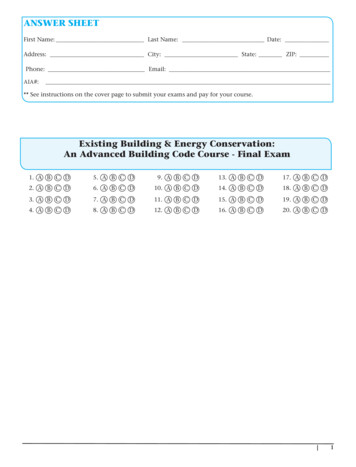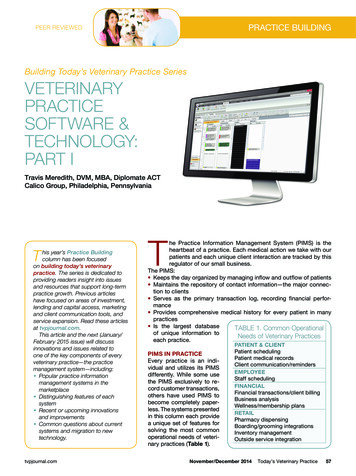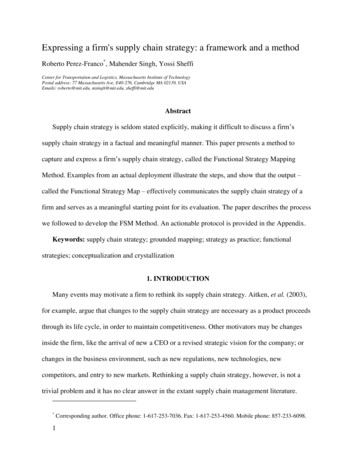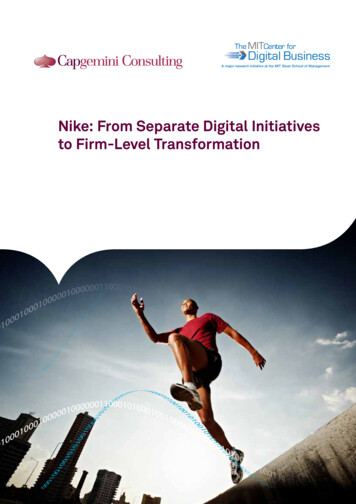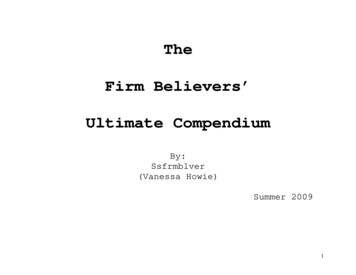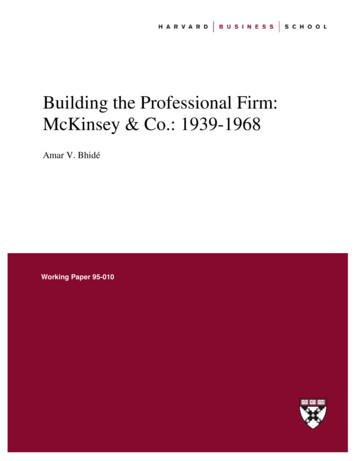
Transcription
Building the Professional Firm:McKinsey & Co.: 1939-1968Amar V. BhidéWorking Paper 95-010
Building the Professional Firm:McKinsey & Co.: 1939-1968Amar V. BhidéHarvard Business SchoolWorking Paper 95-010Copyright 1995, 2020 by Amar V. Bhidé.Working papers are in draft form. This working paper is distributed for purposes of comment and discussion only. It maynot be reproduced without permission of the copyright holder. Copies of working papers are available from the author.Funding for this research was provided in part by Harvard Business School.
Building the Professional Firm:McKinsey & Co.: 1939-1968byAmar V. Bhidé95-010Rev. July 2020 1995 by Amar Bhidé
AbstractThis case history analyzes how the founders of McKinsey & Co. built one of the world's leadingmanagement consulting firms by developing a “system” of professional norms, approach to serving clients,personnel policies, organization, governance, and ownership. The history also shows that whileMcKinsey’s founders resorted to considerable trial and error, it was not ad hoc: they intended to discoverthe best means to further a long-term vision and strategy. Moreover, their vision and strategy derived morefrom a priori faith and personal values than from scientific evidence or financial calculation.
Amar BhidéAmar Bhidé1995, Rev. 2020Building the Professional Firm:McKinsey & Co.: 1939-1968The subject of this study, McKinsey & Co., is a professional service firm, where the challenge ofinvesting in organizational capabilities and competences comes with a twist: because the reputations,knowledge, and other intangible assets of a firm are closely tied to individual firm members, the firm'sowners cannot fully capture the returns from their investment in such assets. For example, employees canleave with clients their firm had cultivated and the skills and training their firm had paid for. Even if thefirm owners do control client relationships and expertise, they may avoid loss through defections, but theycannot fully realize the value of their investments through sale of the enterprise. As a result, they tend tounderinvest in these crucial intangible assets. 1 Many professional firms, therefore, represent little morethan a convenient, often temporary banding of individuals. They invest little in organizationalinfrastructure, avoid opening many offices, and rely on the knowledge and training provided, as a publicgood, by universities and research institutions.McKinsey provides an instructive counterexample. The firm's owners have shown an unusualwillingness to invest in the organization's infrastructure, reputation, and capabilities. McKinsey hasestablished (as of 2020) more than 130 offices located in more than 65 countries. It conducts pro-bonostudies that bring its partners into contact with influential members of the community. It invests in buildinga reputation for management expertise by encouraging its staff to publish articles and books. In its researchbudgets, McKinsey matches top business schools. Training is, according to Business Week, "comprehensiveand constant." 2 In addition, the firm invests the valuable billable hours of senior professionals in evaluatingand providing feedback to its members to improve their skills and build a reputation for quality work. Aclient impact committee oversees the evaluation of how much difference a consultant's work makes to aclient and passes its findings on to the promotion and evaluation committees. And just as the magnitudeof McKinsey's investment in firm building is noteworthy, so is the firm's longevity. At many consultingfirms, discord over what individuals or strategies to invest in and how to divide the returns have led todefections, sale, or dissolution. 3How has McKinsey developed what might be called the "meta-capability" of investing in firmassets -- the sine qua non for all other competencies and capabilities? This case history suggests that thefirm has developed a system whose every element is crucial. (See Table 1). For example, the ownership planrequires departing partners to sell their shares at book value (which is lower than the economic value).Aspiring partners can thus expect to buy stock at a low price and are dissuaded from leaving to start theirown firms. But the plan can also discourage older partners from making long-term investments. Thedisincentive has been neutralized by the other elements of the system, which selects individuals who arepredisposed to institution building and reinforces their innate preferences.This revision of my 1995 working paper merely shortens the original and does not reflect any laterchanges at McKinsey & Co or in my analysis.Unless otherwise stated, the data and quotes are drawn from two Harvard Business School teaching cases-- McKinsey & Company (A): 1956 (Case No. 393-066) and McKinsey & Co. (B) (Case No. 393-067) Iwrote in 1993. The cases were based on my interviews with several active and former McKinsey partners,two partners' memoirs (privately published, for the exclusive use of the firm's personnel), firm archivesfrom the 1940s and 1950s, and the author's experiences as an associate at McKinsey from 1980 to 1985.Several McKinsey partners reviewed the cases for accuracy but made no effort to influence tone orcontent. I wish to thank the firm for generously making their time, writings, and records available to me.
Table 1: The McKinsey "System" and Its EvolutionGoalsBuild prestigious firm that will last in perpetuityClient StrategyServe large prestigious clients on top managementproblemsCharge premium feesFocus exclusively on consultingWorldwide clientele served through local officesFrom inception in 19391939 goal; took about 10 years to implementFees raised as reputation and clientele improvedAvoided audit and accounting from the beginning, butmaintained executive recruiting until 1951Initially East Coast only, national expansion after 1944,European entry in 1959Investment in Knowledge Building andDisseminationFrom inception; first seminars and publications in 1940Emphasis on "Professionalism"From inception; formal code established in 1974Investment in TrainingFirmwide daylong sessions from inception; longerspecialized programs added laterOwnership PlanLimit ownership to active firm membersCorporation with stock bought and sold at book5% cap on individual ownershipSelection and RecruitmentValue intellectual abilities over experienceRecruit from top business schoolsPersonal qualities of leadership, team building as highlyvalued as intellectual abilitiesHire "partner" material onlyAdvancement and TerminationsPartnership based on "economic self-sufficiency" andleadership abilityPromote from within"Up or out" for junior personnelNo "lifetime" partnership; typically "peak in their 40s"From inceptionAdopted in 195625% cap introduced in 1956, later reduced to 5%Initial aspirations stymied by personnel shortages inWWIIStarted at Harvard Business School in 1954Origins unknown, formally articulated in 1950sFormally articulated in 1952Rigorously applied in opening European offices after1959First version, adopted in 1954; subsequently modifiedFirst partner eased out in 1952CompensationCompensate more than industryPerformance-based partnership compensation withhigh varianceConsiderable weight to "firm-building" activitiesFirm Governance and ManagementBroad based, consensual decision making"One firm policy"Fact-based and fair personnel decisionsSpirit of partnershipDeemphasis of hierarchy with "Responsibility fordissent"Multi-round secret ballots with "write-in" nominees toelect firm head1939 policy implemented as firm built clientele andincreased billingsFrom inception; criteria and processes first formalized inearly 1950s-Do-From inception; implemented through committees andtask forces after early 1950sImplemented and evolved as offices addedFormal criteria and processes first adopted in the 1950sFrom inceptionEspoused from inception; traditions established overtimeAdopted in 1968. Clee (1939-50) and Bower (1950-67)routinely reelected previouslyThe evolution of McKinsey's system owes much to the unusual qualities of Marvin Bower, who co-foundedthe firm in 1939 and served as its managing partner between 1950 and 1967. Although luck certainly playeda role, McKinsey's development is not a story of the selection of the fittest random mutations. Rather it2
reflects a long-term vision that derived more from personal beliefs and values than from scientific evidenceor financial calculation.In the pages that follow, I describe how the formative experiences of the founders shaped theirgoals and assumptions about building a consulting firm. Next, I describe developments from 1939 to 1968.We will see how over these decades McKinsey built its economic base in the United States, formulated andimplemented the critical internal, or organizational, elements of its system, and then rapidly tookadvantage of opportunities to grow internationally. The overview of the firm's history then serves as a basisfor the concluding section of the paper, which discusses the McKinsey system in greater detail, the difficultyof imitating the McKinsey formula, and the implications of the McKinsey story for other firms.Marvin Bower: Formative ExperiencesMarvin Bower and two co-founders started McKinsey & Co. in 1939, to take over the failing EastCoast practice of McKinsey, Wellington & Co. McKinsey, Wellington had been formed in 1935 through amerger of James O. McKinsey & Company and Scovell, Wellington & Company. Many of the goals andpolicies that McKinsey's founders espoused in 1939, including its focus on consulting to top managers, itsemphasis on professionalism and training, its client development approach, and its egalitarian, consensualculture were shaped by Bower's educational and family background, his experiences at McKinsey's twoantecedent firms, and a brief legal career.Bower had graduated from Brown University in 1925 and Harvard Law School in 1928, when hehad first applied for a position at Jones, Day, one of the most prestigious firms in his hometown ofCleveland. Jones, Day turned Bower down because his law school grades weren't high enough. Bower thenenrolled at Harvard Business School and finished the first year of the MBA program in the top 5% ofstudents, enabling him to secure the position at Jones, Day he been turned down for.At Jones, Day, Bower had the opportunity to work with Mr. Ginn, the firm’s senior partner."Because I had heard so much about him and the firm he had shaped," Bower recalls, "I made it animmediate objective to learn why it had been so successful. From observation and analysis during my Jones,Day years began the formulation of the program that I later brought with me to McKinsey." Bower wasimpressed with the firm's professional approach, recruiting standards, and the prominence of its partnersin Cleveland's charitable, social, and cultural organizations.The Jones, Day experience also persuaded Bower of the opportunity to create a top-qualitymanagement consulting firm. During the Great Depression, bondholders' committees gained control ofCleveland companies that defaulted on their bonds and asked Jones, Day for assistance. Thanks to Bower'sbusiness education, he became secretary of several committees; in that role, he studied the potential earningpower of distressed companies and proposed recapitalization structures. Viewing his studies as"amateurish and superficial," he saw the need for a firm to handle these problems in the same professionalway as Jones, Day handled legal problems. Bower was therefore pleased in 1933 when James O. McKinsey("Mac" 1), a certified public accountant and professor at the University of Chicago, asked him to join theNew York office of James O. McKinsey & Company (JOM), a firm specializing in accounting and what wasthen known as "management engineering." Bower believed he could help develop JOM into the kind offirm he had envisioned.James O. McKinsey had founded the firm bearing his name in 1926. Mac had seen an opportunity1I will use "Mac" to avoid confusion with the firm bearing his name. It is also noteworthy that, unlike the other professionalfirms of the era, the staff at James O. McKinsey and Company and its successor firms addressed each other by their first names (orabbreviations), regardless of their rank or status. The practice was intended to promote collegiality and a nonhierarchical culture.3
to advise managers during World War I, when he served in the Army Ordnance Department and dealtwith suppliers of war material. Seeking a reputation as a management expert, Mac -- who had alreadyobtained bachelor’s degrees in pedagogy, law, and philosophy from three different colleges -- became acertified public accountant and received a Master of Arts degree in 1919. In 1920, he was appointed assistantprofessor of accounting at the University of Chicago. Mac wrote books, lectured to business groups, andbecame a junior partner in a firm that provided organizational, accounting, and industrial managementadvice.Mac's and Bower's backgrounds together shaped the firm that Bower would later launch in severalways. Apparently, Bower was always keen on associating with well-regarded institutions -- Brown,Harvard, and Jones, Day -- which likely contributed to his desire to build a prestigious firm. At the sametime, he came from a Cleveland family of modest means, and Mac had been raised on a farm in Missouri,which probably fostered a pragmatic and meritocratic orientation -- McKinsey would be prestigious butnot genteel.Both men also unquestioningly believed in investing in intellectual capital -- no effort was made atJOM or later to measure the returns on such investments. Mac ran training meetings at JOM like theprofessor he still was. Mac's "text" was the General Survey Outline -- a checklist that reflected JOM's"integrated" or "top-management" approach. The Outline forced a strategic approach to client studies byrequiring consulta
Several McKinsey partners reviewed the cases for accuracy but made no effort to influence tone or content. I wish to thank the firm for generously making their time, writings, and records available to me. Amar Bhidé . 1995, Rev. 2020 . Building the Professional Firm: McKinsey & Co.: 1939-1968 . The subject of this study, McKinsey & Co., is a professional service firm, where the challenge of .





